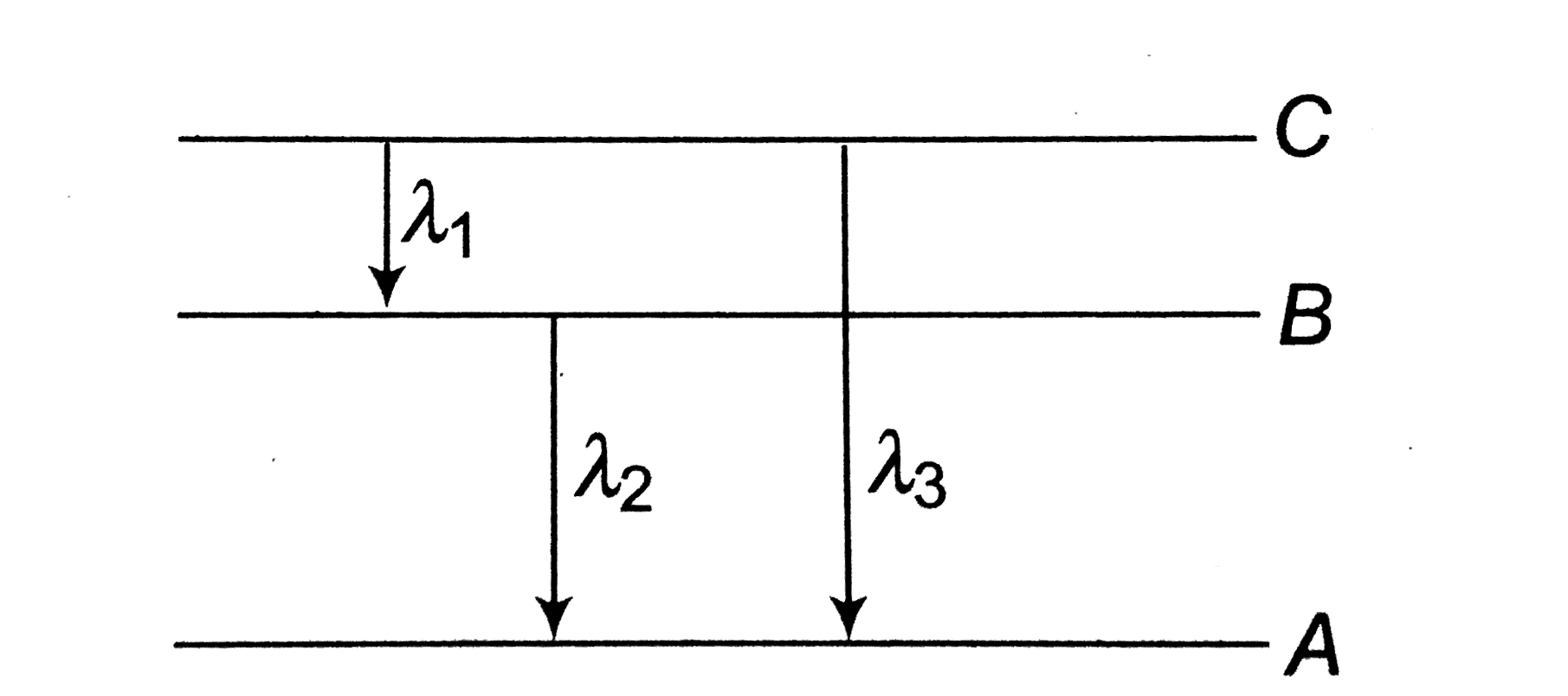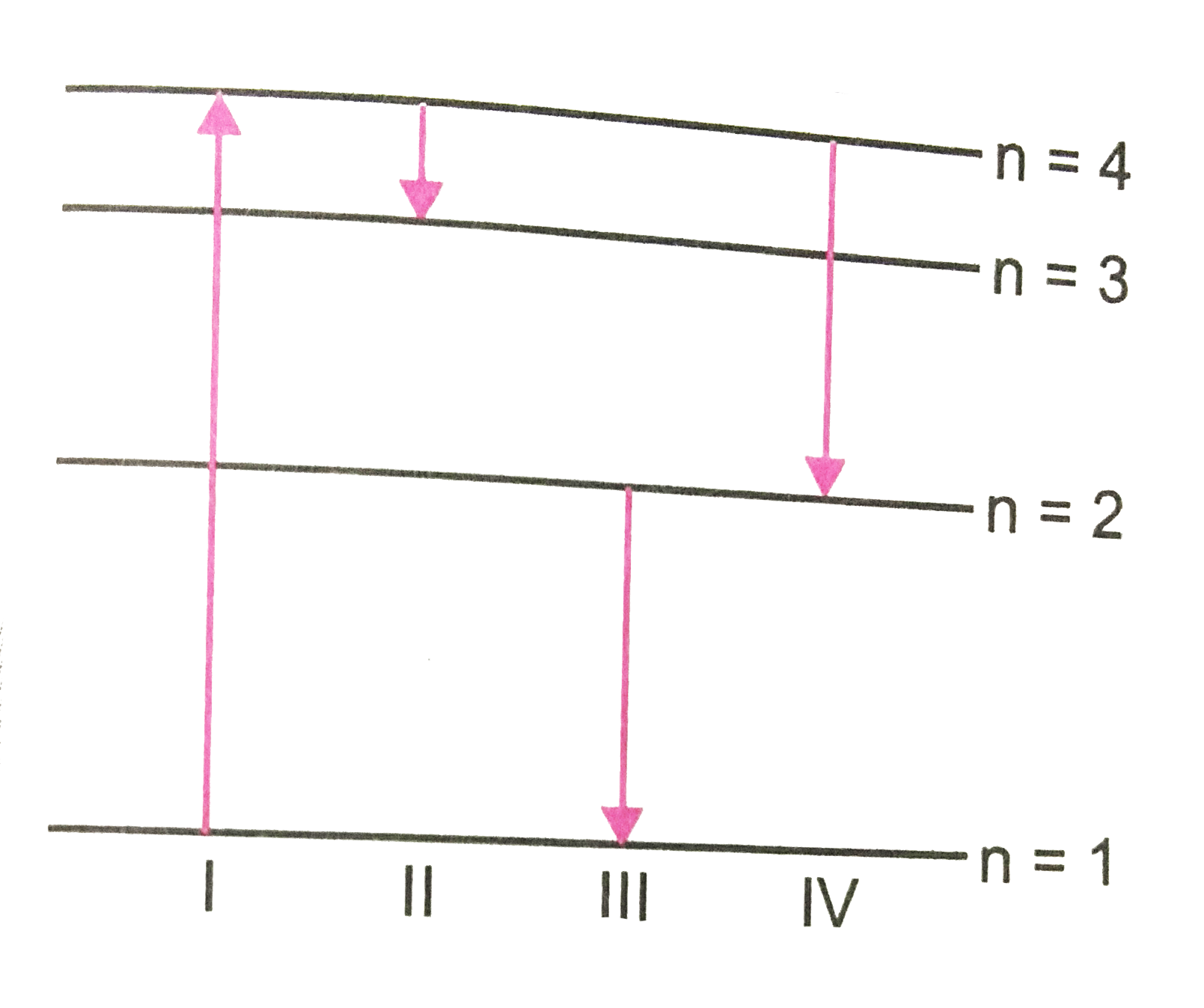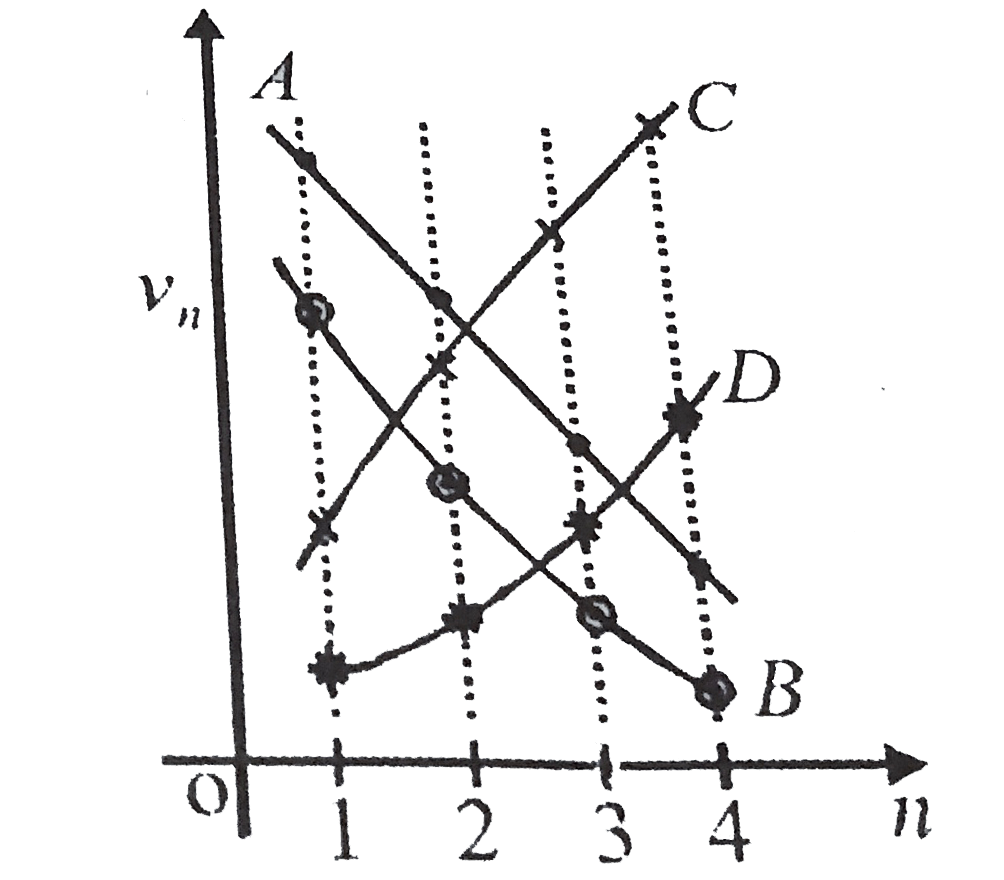Complete Solutions to PHYSICS of chapter ATOMS of Class 11 book with complete answers and questions
| Class 11 | PHYSICS |
| Chapter | ATOMS |
| DISHA | PHYSICS |
| Number Of Questions | 74 |
| Academic Year | 2023-24 |
If the following atoms and molecylates for the transition from `n = 2` to `n = 1`, the spectral line of minimum wavelength will be produced by
View SolutionThe Lyman series of hydrogen spectrum lies in the region :
View SolutionThe energy levels of the hydrogen spectrum is shown in figure. There are some transitions `A, B, C, D` and `E`. Transition `A, B`, and `C` respectively represent

View SolutionEnergy levels `A, B, C` of a certain atom corresponding to increasing values of energy i.e., `E_(A) lt E_(B) lt E_(C)`. If `lambda_(1), lambda_(2), lambda_(3)` are the wavelengths of radiations correspnding to the transitions `C` to `B, B` to `A` and `C` to `A` respectively, which o fthe following statements is correct?

View SolutionIf `m` is mass of electron, `v` its velocity, `r` the radius of stationary circular orbit around a nucleus with charge `Z_(e)`, then from Bohr's first postulate, the kinetic energy `k = (1)/(2)mv^(2)` of the electron in `C.G.S.` system is equal to
View Solutionwhen a hydrogen atom is raised from the ground state to an excited state
View SolutionThe ratio of the kinetic energy to the total energy of an eelctron in a Bohr orbit is
View SolutionThe ratio of the frequencies of the long wavelenght limits of Lyman and Balmer series of hydrogen spectrum is
View SolutionRatio of the wavelength of first line of Lyaman series and first line of Balmer series is
View SolutionAccording to Bohr's theory the moment of momentum of an electron revolving in second orbit of hydrogen atom will be
View SolutionIn the Bohr model of a hydrogen atom, the centripetal force is furnished by the Coulomb attraction between the proton and the electrons. If `a_(0)` is the radius of the ground state orbit, `m` is the mass and `e` is the charge on the electron and `e_(0)` is the vacuum permittivity, the speed of the electron is
View SolutionWhich of the following transition in hydrogen atom emit photons of biggest frequency ?
View SolutionAs par Bohr model, the minimum energy (in `eV`) required to remove an electron from the ground state of doubly ionized `Li` atom `(Z = 3)` is
View SolutionThe third line of Balmer series of an ion equivalent to hydrogen atom has wavelength of `108.5mm`. The ground state energy of an electron of this ion will e
View SolutionThe wavelength of radiation emitted is `lambda_(0)` when an electron jumps from the third to the second orbit of hydrogen atom. For the electron jump from the fourth to the second orbit of hydrogen atom, the wavelength of radiation emitted will be
View SolutionThe energy of electron in the nth orbit of hydrogen atom is expressed as `E_(n) = (-13.6)/(n^(2))eV`. The shortest and longest wavelength of Lyman series will be
View SolutionConsider a hydrogen-like atom whose energy in nth excited state is given by
`E_(n) = (13.6 Z^(2))/(n^(2))`
When this excited makes a transition from excited state to ground state , most energetic photons have energy
`E_(max) = 52.224 eV`. and least energetic photons have energy
`E_(max) = 1.224 eV`
Find the atomic number of atom and the intial state or excitation.
View SolutionIn the Bohr model of the hydrogen atom, let R, v and E represent the radius of the orbit, the speed of electron and the total energy of the electron respectively. Which of the following quantity is proportional to the equantum number n
View SolutionAn `alpha`-particle of `5MeV` energy strikes with a nucleus of uranium at stationary at an scattering angle of `108^(@)`. The nearest distance up to which `alpha`particle reaches the nuvles will be of the order of
View SolutionIn a hypotherical Bohr hydrogen, the mass of the electron is doubled. The energy `E_(0)` and the radius `r_(0)` of the first orbit will be (`a_(0)` is the Bohr radius)
View SolutionThe electron in a hydrogen atom makes a transition `n_(1) rarr n_(2)`, where `n_(1)` and `n_(2)` are the principle quantum numbers of the two states. Assume the Bohr model to be valid. The time period of the electron in the initial state is eight times that in the final state. the possible values of `n_(1)` and `n_(2)` are
View SolutionA free hydrogen atom in gourn state is at rest. A neutron of kinetic energy K collides with the hydrogen atom. After collision hydrogen atom eits two photons in succession one of which has energy 2.55eV. Assume that the hydrogen atom and neutron has same mass.
(1) Minimum value of K is 25.5eV
(2) Minimum value of K is 12.75 eV
(e) The other photon has energy 10.2eV
(4( The upper energy level is of excitation energy 12.5 eV
View SolutionWhich of the series of hydrogen spectrun are not in the visible region?
View SolutionA gas of identical hydrogen like atomos has some atoms in ground state and some atoms in a particular exceited state and dthere are no atoms in any other energy level. The atoms of the gas make transition to a higher energy stte by absrobing monochromatic light of wavelenght 304 `overset(@)A`. Subsequencly, the atoms emit radiation of only six different photon energies. Some of emitted photons have wavelenght `304 overset(@)A`, some wavelength more and some have less that `304 overeset(@)A` (Take he=12420eV`-overset(@)A`)
Find the principal quantum number of the initially excicted state.
View SolutionA gas of identical hydrogen like atomos has some atoms in ground state and some atoms in a particular exceited state and dthere are no atoms in any other energy level. The atoms of the gas make transition to a higher energy stte by absrobing monochromatic light of wavelenght 304 `overset(@)A`. Subsequencly, the atoms emit radiation of only six different photon energies. Some of emitted photons have wavelenght `304 overset(@)A`, some wavelength more and some have less that `304 overeset(@)A` (Take he=12420eV`-overset(@)A`)
Identify the gas (Z=?)
View SolutionA gas of identical hydrogen like atomos has some atoms in ground state and some atoms in a particular exceited state and dthere are no atoms in any other energy level. The atoms of the gas make transition to a higher energy stte by absrobing monochromatic light of wavelenght 304 `overset(@)A`. Subsequencly, the atoms emit radiation of only six different photon energies. Some of emitted photons have wavelenght `304 overset(@)A`, some wavelength more and some have less that `304 overeset(@)A` (Take he=12420eV`-overset(@)A`)
Find the maximum and minimum energies of emitted photosn (in eV)
View SolutionAssertion: Bohr had to postulate that the electrons in stationary orbits around the nucleus do not radiate.
Reason: According to classical physical all moving electrons radiate.
View SolutionAssertion: The force of repulsion between atomic nucleus and `alpha`-particle varies with distance according to inverse square law.
Reason: Rutherford did `alpha`-particles scattering experiment.
View SolutionAssertion: Hydrogen atom consists of anly one electron but its emission spectrum has may lines.
Reason: Only Lyman series is found in the absorption spectrum of hydrogen atom whereas in the emission spectrum, all the series are found.
View SolutionThe potential energy associated with an electron in the orbit
View SolutionShows the energy levels for an electron in a certain atom. Which transition shown represented the emission of a photon with the most energy?

View SolutionElectrons in a certain energy level `n=n_(1)` can emit 3 spectral lines. When they are in another energy level, `n=n_(2)`, they can emit 6 spectral lines. The orbital speed of the electrons in the two orbits are in the ratio
View SolutionIn Rutherford scattering experiment, the number of `alpha`-particles scattered at `60^(@)` is `5 xx 10^(6)`. The number of `alpha`-particles scattered at `120^(@)` will be
View SolutionIn the Bohr model an electron moves in a circular orbit around the proton. Considering the orbiting electron to be a circular current loop, the magnetic moment of the hydrogen atom, when the electron is in nth excited state, is :
View SolutionA `12.5 eV` electron beam is used to excite a gaseous hydrogen atom at room temperature. Determine the wavelengths and the corresponding series of the lines emitted.
View SolutionA hydrogen atom and a `Li^(2+)` ion are both in the second excited state. If `l_H` and `l_(Li)` are their respective electronic angular momenta, and `E_H and E_(Li)` their respective energies, then
(a) `l_H gt l_(Li) and |E_H| gt |E_(Li)|`
(b) `l_H = l_(Li) and |E_H| lt |E_(Li)|`
(C ) `l_H = l_(Li) and |E_H| gt |E_(Li)|`
(d) `l_H lt l_(Li) and |E_H| lt|E_(Li)|`
View SolutionThe radius of hydrogen atom in its ground state is `5.3 xx 10^(-11)m`. After collision with an electron it is found to have a radius of `21.2 xx 10^(-11)m`. What is the principle quantum number of `n` of the final state of the atom ?
View SolutionWhen hydrogen atom is in first excited level, its radius is….its ground state radius
View SolutionConsider `3rd` orbit of `He^(+)` (Helium) using nonrelativistic approach the speed of electron in this orbit will be (given `K = 9 xx 10^(9)` constant `Z = 2` and `h` (Planck's constant) `= 6.6 xx 10^(-34)Js`.)
View SolutionAn electron in the hydrogen atom jumps from excited state `n` to the ground state. The wavelength so emitted illuminates a photo-sensitive material having work function `2.75eV`. If the stopping potential of the photoelectron is `10V`, the value of `n` is
View SolutionThe electron in a hydrogen atom makes a transition from an excited state to the ground state. Which of the following statements is true?
View SolutionAs energy of `24.6 eV` is required to remove one of the required to remove both the electrons from a nuture brfore alon is
View SolutionOne of the lines in the emission spectrum of `Li^(2+)` has the same wavelength as that of the `2nd` line of Balmer series in hydrogen spectrum. The electronic transition corresponding to this line is:
View SolutionIf the atom`(_100)Fm^(257)` follows the Bohr model the radius of `_(100)Fm^(257)` is `n` time the Bohr radius , then find `n` .
View SolutionThe energy of He+ in the ground state is `-54.4 eV`, then the energy of `Li^(++)` in the first excited state will be
View SolutionIf the angular momentum of an electron in an orbit is J then the K.E. of the electron in that orbit is
View SolutionSuppose an electron is attracted toward the origin by a force`(k)/(r )` where `k` is a constant and `r` is the distance of the electron from the origin .By applying Bohr model to this system the radius of the `n^(th)` orbital of the electron is found to be `r_(n)` and the kinetic energy of the electron to be `T_(n)` , Then which of the following is true ?
View SolutionIn hydrogen spectrum the wavelength of `H_(a)` line is `656nm, ` where in the spectrum of a distance galaxy `H_(a)` line wavelength is `706 nm` . Estimated speed of the galaxy with respect to earth is ,
View SolutionIn the hydrogen atom, an electron makes a transition from n=2 to n=1. The magnetic field produced by the circulating electron at the nucleus
View SolutionWhat is the radius of iodine atom (at no. `53`, mass number `126`)?
View SolutionWhen an `alpha-`particle of mass 'm' moving with velocity 'v' bombards on a heavy nucleus of charge 'Ze' its distance of closest approach from the nucleus depends on `m` as :
View SolutionThe ionization enegry of the electron in the hydrogen atom in its ground state is `13.6 ev`. The atoms are excited to higher energy levels to emit radiations of `6` wavelengths. Maximum wavelength of emitted radiation corresponds to the transition between
View SolutionThe wavelength involved in the spectrum of deuterium `_(1)^(2)D` are slightly different from that of hydrogen spectrum because
View SolutionThe electron in a hydrogen atom makes a transition `n_(1) rarr n_(2)`, where `n_(1)` and `n_(2)` are the principle quantum numbers of the two states. Assume the Bohr model to be valid. The time period of the electron in the initial state is eight times that in the final state. the possible values of `n_(1)` and `n_(2)` are
View SolutionIn a hydrogen like atom electron make transition from an energy level with quantum number `n` to another with quantum number `(n - 1)` if `n gtgt1` , the frequency of radiation emitted is proportional to :
View SolutionThe spectrum obtained from a sodium vapour lamp is an example of
View SolutionIonization potential of hydrogen atom is `13.6 V`. Hydrogen atoms in the ground state are excited by monochromatic radiation of photon energy `12.1 eV`. The spectral lines emitted by hydrogen atoms according to Bohr's theory will be
View SolutionThe Bohr model of atoms
View SolutionThe largest wavelength in the ultraviolet region of the hydrogen spectrum is `122` nm. The smallest wavelength in the infrared region of the hydrogen spectrum (to the nearest integer) is
View SolutionA doubly ionised Li atom is excited from its ground state(n = 1) to n = 3 state. The wavelengths of the spectral lines are given by `lamda_(32), lamda_(31)` and `lamda_(21)`. The ratio `l_(32)//lamda_(31)` and `l_(21)//l_(31)` are, respectively
View SolutionIn Rutherford scattering experiment, what will b ethe correct angle for `alpha` scattering for an impact parameter `b = 0` ?
View SolutionConsider `3rd` orbit of `He^(+)` (Helium) using nonrelativistic approach the speed of electron in this orbit will be (given `K = 9 xx 10^(9)` constant `Z = 2` and `h` (Planck's constant) `= 6.6 xx 10^(-34)Js`.)
View SolutionThe ionisation energy of hydrogen atom is `13.6 eV`. Following Bohr's theory, the energy corresponding to a transition between the `3`rd and the `4`th orbit is
View SolutionThe transition form the state `n = 3` to `n = 1` in a hydrogen-like atom results in ultraviolet radiation. Infared radiation will be obtained in the transition from
View SolutionGiven the value of Rydberg constant is `10^(7)m^(-1)`, the waves number of the lest line of the Balmer series in hydrogen spectrum will be:
View SolutionWhich of the plots shown in the figure represents speed `(v_n)` of the electron in a hydrogen atom as a function of the principal quantum number (n)?

View SolutionThe ionisation potential of `H`-atom is `13.6 eV`. When it is excited from ground state by monochromatic radiations of `970.6 Å`, the number of emission lines will be (according to Bohr's theory)
View SolutionIf the energy of a hydrogen atom in `nth` orbit is `E_(n)`, then energy in the nth orbit of a singly ionised helium atom will be
View SolutionIn the Rutherford experiment, `alpha`-particles are scattered from a nucleus as shown. Out of the four paths, which path is not possible?

View SolutionAn electron changes its position from orbit `n = 4` to the orbit `n = 2` of an atom. The wavelength of the emitted radiation's is `(R =` Rydberg's constant)
View SolutionIn a Rutherford scattering experiment when a projectile of change `Z_(1)` and mass `M_(1)` approaches s target nucleus of change `Z_(2)` and mass `M_(2)`, te distance of closed approach is `r_(0)`. The energy of the projectile is
View SolutionThe wavelength of the first spectral line in the Balmer series of hydrogen atom is `6561 A^(@)` . The wavelength of the second spectral line in the Balmer series of singly - ionized helium atom is
View SolutionLet `v_(1)` be the frequency of series limit of Lyman series, `v_(2)` the frequency of the first line of Lyman series and `v_(3)` the frequency of series limit of Balmer series. Then which of the following is correct ?
View SolutionIn a hypotherical Bohr hydrogen, the mass of the electron is doubled. The energy `E_(0)` and the radius `r_(0)` of the first orbit will be (`a_(0)` is the Bohr radius)
View Solution
PHYSICS questions and complete solutions for chapter ATOMS of DISHA PHYSICS (HINGLISH) of Class 11